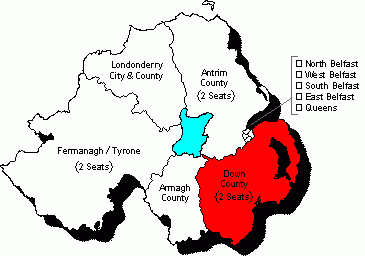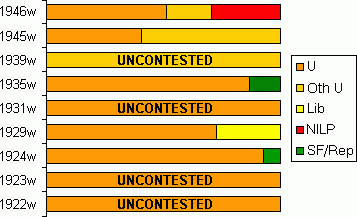

 |

|
| |
|
|
Tuesday April 1, 2025
|

|

|
| Map and diagram by Conal Kelly | |
This two seat constituency covered the south-eastern corner of Northern Ireland, incorporating all of county Down (excluding Belfast). Established under the terms of the Government of Ireland Act 1920, the constituency replaced the single seat constituencies of East Down, Mid Down, North Down, South Down, and West Down. Unlike single seat constituencies, Down used the plurality-at-large (Block) voting system, where each voter selected up to two candidates, and the two candidates receiving the largest number of votes were the winners. Between 1922 and 1949 the constituency was represented by five different MPs (4 Unionists, 1 Independent Unionist). The general elections of 1922, 1923, and 1931 and the single seat by-election of 1939 went uncontested. The declared winners in each case were the Unionist nominees. The constituency had the lowest turn-out across Northern Ireland in the 1935, and 1945 general elections.
See also election results for South Down 1950-1970, 1973-1982, 1983-1992 and 1993-2007.
| U | Ind U | Lib | NILP | SF/Rep | |
| 1946w-b | 51.4% | 19.3% | 29.3% | ||
| 1945w | 40.5% | 59.5% | |||
| 1939w-b | * | ||||
| 1935w | 86.7% | 13.3% | |||
| 1931w | * | ||||
| 1929w | 72.5% | 27.5% | |||
| 1924w | 92.9% | 7.1% | |||
| 1923w | * | ||||
| 1922w | * |
* The only candidates nominated for the 1922 and 1923 General Elections were Unionists David Reid and Rev John Simms. The only candidates nominated for the 1931 General Election were Unionists David Reid and Viscount Castlereagh. The only candidate nominated for the 1939 By-Election was Unionist Rev. James Little. In each instance the nominated candidates were therefore duly elected without a contest.
Unionist majority: 21,853; electorate: 147,978; votes cast: 66.6%
Having achieved one
of the surprise results of the 1945 election, Little passed away in April
1946. The subsequent by-election was held the following June. Determined
to recapture the seat lost in the general election, the Unionist Party
selected Charles Mullan as their candidate. Contesting the election
as an Independent Unionist, was the son of the former MP, James Hastings
Little. Also on the ballot was James Brown who had come within 2,000
votes of taking the second Down seat in 1945. Rounding out the field was
the Northern Ireland Labour Party (NILP), who were contesting the
constituency for the first time, with their candidate Desmond Donnelly.
Despite a good performance by the NILP, Mullan was able to secure a
comfortable majority of almost 22,000 votes.
Mullan had unsuccessfully contested the South Down seat at the 1945
Northern Ireland general election. Donnelly had unsuccessfully contested
the English constituency of Evesham as a Common Wealth Party candidate in
the 1945 Westminster election. Brown would go on to stand unsuccessfully
in South Down as an Unionist Party candidate in the 1958 Northern Ireland
general election.
Unionist majority: 1,418; electorate: 145,524; votes cast: 39.8% (Note: each voter selects up to two candidates)
This was one of the
more interesting contests of the period. The Unionist Party brought forward
two new candidates for the 1945 election, namely Sir Walter Smiles and John
Blakiston-Houston. Viscount Castlereagh had stepped down leaving one vacancy
but a dispute over selection, resulted in 1939 by-election winner, Rev. James
Little, opting to run as an Independent Unionist. Little was joined on the
Independent Unionist ticket by James Brown. In somewhat of a surprise result,
Little topped the poll, taking over 40% of the vote. Brown came within 2,000
votes of taking the second seat. At 39.8%, Down once more had the lowest
turn-out of the election across Northern Ireland.
Smiles was the Conservative MP for Blackburn from 1931 to 1945. Brown had
been elected to the Northern Ireland House of Commons in the 1938 general
election, standing as an Independent Farmers and New Industries candidate
in South Down. He lost his seat in the 1945 general election, standing as
an independent Unionist in Mourne. Blakiston-Houston had previously contested
the 1935 general election in Fermanagh and Tyrone.
His grandfather had been the MP for North Down between 1898 and 1900 and his
uncle sat for Belfast Dock in the Northern Ireland House of Commons between
1929 and 1933.
Unopposed Independent Unionist Candidate.
Following the death of Reid in March 1939, a by-election was held the following May. The Unionist Party selected Rev. James Little to defend the seat they had held since 1922. Such was the dominant position of the Unionist Party, no challengers were nominated and Little was returned unopposed.
Unionist majority: 45,593; electorate: 134,467; votes cast: 56.7% (Note: each voter selects up to two candidates)
Defending their seats in 1935, Reid and Castlereagh would face a new opponent in the form of Republican candidate Patrick O'Hagan. O'Hagan managed to attract just over 13% of the vote and so the result was a comfortable victory for Reid and Castlereagh, garnering over 130,000 votes between them. At 56.7%, Down had the lowest turn-out of the election across Northern Ireland.
Unopposed Unionist Candidates.
Following Simms's
retirement, the Unionists chose Viscount Castlereagh to join Reid on the
ticket. As was the case in 1922 and 1923, the Unionist Party faced no
opposition in Down in 1931 and so Reid and Castlereagh were returned
to Westminster unopposed.
Castlereagh's father had been elected to the House of Commons in 1906
for the English constituency of Maidstone.
Unionist majority: 32,944; electorate: 127,346; votes cast: 58.5% (Note: each voter selects up to two candidates)
Once again the Unionist
Party nominated Reid and Simms to defend the two Down seats. Their opposition
would come from the Liberal Party who nominated Robert Pollock and David Johnston.
This was one of four constituencies being contested by the Liberals in 1929. While
the Liberal candidates managed to collectvely gather over 27% of the vote, the
Unionist pairing were comfortably returned with over 100,000 votes between them.
Johnston had also stood unsuccessfully in East Down in the 1929 Northern Ireland
general election.
Unionist majority: 49,836; electorate: 96,285; votes cast: 65.8% (Note: each voter selects up to two candidates)
Unlike the previous two
elections, Reid and Simms would have competition in 1924, in the form of Sinn
Fein candidate Michael Murney. Murney was one of eight candidates fielded by
Sinn Fein in this election. The result was a landslide for Reid and Simms, who
had majorities of almost 50,000 votes.
Murney, a former IRA member, had been imprisoned on multiple occasions and had
been interned on the Argenta prison ship for much of 1924. His brother, Peader,
would later be elected to the Northern Ireland Parliament as a member for South
Down in 1945.
One interesting event during the election was the arrest of Eamon de Valera at
Newry Town Hall after defying an order preventing him from speaking in Northern
Ireland in support of Sinn Fein election candidates. He was subsequently
sentenced under the Special Powers act to a month in the Crumlin Road Gaol in
Belfast.
Unopposed Unionist Candidates.
As was the case in 1922, Reid and Simms were the only candidates nominated in Down and were duly elected without a contest once more. Seven other seats went uncontested in the 1923 general election in Northern Ireland. The sole nominee (and hence winner) in each instance was the Unionist candidate.
Unopposed Unionist Candidates.
This was the first
election in the new two-seat Down constituency. The new constituency replaced
the single seat constituencies of East Down, Mid Down, North Down, South Down,
and West Down. David Reid had represented East Down since the 1918 election.
John Simms had represented North Down since the July 1922 by-election. As the
only nominees in this two-seat constituency, both were duly elected without a
contest.
Reid had unsuccessfully contested the East Tyrone seat in the 1910 Westminster
election. Simms was the Presbyterian Moderator of the General Assembly.
See also:
Results from 1922 to 1949 for each seat: East Belfast | North Belfast | South Belfast | West Belfast | Antrim | Armagh | Down | Fermanagh and Tyrone | Londonderry | Queens University
Other sites based at ARK: ORB (Online Research Bank) | CAIN (Conflict Archive on the INternet) | Northern Ireland Life and Times Survey
Your comments, please! Send an email to me at nicholas.whyte@gmail.com.
Conal Kelly, 10 October 2007.
|
|
Disclaimer:©
Nicholas Whyte 1998-2004 Last Updated on Wednesday, 12-Jan-2005 12:12
|